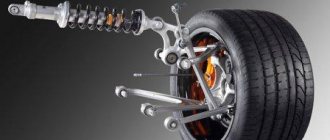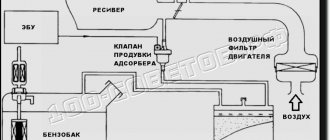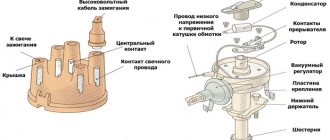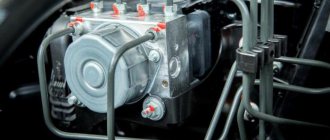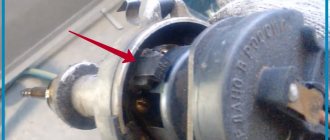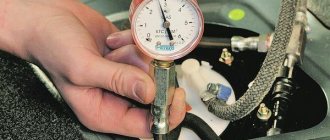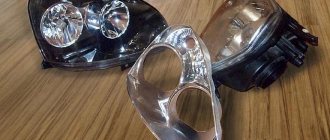It's no secret that the operation of gasoline and diesel engines is based on the combustion of a fuel-air mixture. Formed in the carburetor or injector, it enters the cylinders, after which it ignites and the thermal energy pushes the pistons that drive the engine shafts. As a result, the car drives. The engine operation algorithm is very clearly established, but for its proper organization, not only the timely supply of fuel to the cylinders is important. The spark formation process, which is achieved using the machine’s ignition system, is also important in this system. One of the main components in it is a distributor, which supplies a spark precisely to the spark plug of the cylinder where the piston currently reaches the desired position. We’ll talk in more detail about the operation of this particular part of the machine and its features today.
What is this detail?
A distributor is a part of a car engine that runs on fuel such as gasoline. We are talking about an internal combustion engine, and not some other one. So, it is the distributor that is responsible for the timely provision of an electric pulse to the spark plugs, as a result of which the discharge of the latter is ensured and further ignition of the fuel in the chamber where the pistons are located directly.
In other words, a distributor is an ignition distributor in a car. Which is responsible for getting a spark at the right time. It is worth saying that such a part is available on almost all internal combustion engines. The only thing is that the latter may not be located in the same way and its functionality may differ slightly from one another.
It is also impossible not to take into account the fact that diesel car engines do not have an ignition system, just as injection cars do not have a breaker. For a better understanding, it is worth understanding the structure and principle of operation of the distributor, with which we will now try to approach this issue in more detail.
Octane corrector
This device allows you to mechanically change the OZ depending on the fuel used (octane number) or its quality. You can see the corrector in the figure below.
In fact, these are two plates, one is installed on the distributor and has an arrow, the other is attached to the engine, and there are marks on it. By changing their position in relation to each other, you can mechanically set the desired ignition angle. This is required mainly when using different types of gasoline.
Non-contact systems and a Hall sensor in the distributor The distributor described above is a classic option and has been used for many years on all cars, including the VAZ family, such as 2109, 2106, 2107, 2108. However, as electronics developed, voltage switches began to appear , in which the breaker signal was used not to switch the ignition coil, but to control the electronics. Later, the distributor lost its mechanical breaker and was replaced by a Hall sensor.
The Hall sensor used has a fairly simple design. Yes, it must be recalled that the Hall sensor is an element that responds to a magnetic field. Therefore, the design of the sensor using Hall elements is based on this principle. To do this, a Hall sensor is located directly on the plate, on the other side there is a permanent magnet, and between them there is a rotating metal screen in which special slots are made.
When the screen blocks the field from the installed magnet, the Hall sensor has zero voltage at the output; when windows are opened instead of a solid screen, the Hall sensor generates a high voltage at the output. The distributor transmits this generated sequence of pulses to the voltage switch, and it controls the ignition coil.
At one time, a similar system was implemented in many cars, VAZ 2109, 2106, 2107, 2108 were no exception.
Ignition distributor device
The non-contact type distributor device includes a set of certain elements:
1. Rotor or so-called distributor drive. Which is often represented by a splined shaft that engages with a camshaft gear or a shaft. The difference depends on the design of the motor.
2. Ignition coil, which has a double factory winding.
3. There is also a breaker; there is a cam clutch, as well as a centrifugal clutch and a contact group.
4. A slider that is attached directly to the clutch shaft and rotates when working with it. There is also a distributor cap. It is from this that the high-voltage wiring goes to all the spark plugs.
5. Vacuum-type ignition timing advance regulator. A capacitor is also included in its circuit. It functions as a “lightning rod”, since it is it that takes on a little charge, protecting the group of contacts from melting under the influence of high voltage.
6. Depending on the type of distributor, an octane corrector can also be installed in the lower part of the structure, which controls the speed of revolutions, depending on the brand of gasoline. Have you ever heard of the concept of octane number? This is what it is, only in the classic versions its correction is done with your own hands.
Distributor design
The distributor circuit assumes the presence of such elements as:
- low voltage current breaker;
- high voltage current distributor;
- centrifugal ignition timing regulator;
- vacuum ignition timing regulator.
The distributor circuit is designed so that at a certain moment the breaker opens the primary ignition circuit, as a result of which a high voltage current is created in the secondary winding of the ignition coil. Through the distributor, this current is transmitted to the spark plugs in certain cylinders. The regulators automatically adjust the ignition timing, which depends on the current operating mode of the engine.
Distributor device
The distributor breaker is an electromechanical part and consists of the following parts:
- shaft;
- movable contact plate;
- movable contact plate;
- capacitor;
- frame.
The breaker shaft consists of two main parts. On one of them, depending on the type of breaker, cams are installed, the number equal to the number of cylinders in the engine. This distributor device is not very reliable, since a large number of contacts, as well as the presence of moving parts, lead to regular problems with this unit.
The distributor device, as well as its use in general, are outdated from the point of view of modern electrical equipment, but in our country there are still a lot of carburetor engines, so the problem of the performance of this unit is currently relevant.
As for where the distributor is located in the car, most often it can be found under the hood next to the engine, near the cylinder head or on it. Although the exact location of the node depends solely on the model of the machine.
What is the operating principle?
How does a car distributor work? Everything is banal and simple. When you turn the key in the car, the electrical circuit is closed and voltage is then supplied from the battery directly to the starter. After that, such a starter part as bendix provides engagement with the crankshaft flywheel, and from there the supply continues to the ignition distribution roller drive gear.
A low-voltage current appears on the coil as the circuit closes. This is where the contacts of the breaker are separated and the high-voltage voltage accumulates on the second circuit of the same coil. Then the resulting current goes to the cover due to the graphite contact or brush located in the lower part of the part.
At the same time, the slider is constantly in contact with the central electrode and, when rotating, distributes part of the voltage alternately to the contact of each of the spark plugs. In other words, the voltage is divided equally among all four spark plugs. This is how the general operating principle of the distributor works.
How the distributor works and how it works
This mechanism includes many components for various purposes. The main ones among them are the following:
- rotor - provides traction with the rotating camshaft gears;
- breaker - a module with a cam clutch, which is connected by special contacts to a centrifugal clutch;
- ignition coil equipped with double winding;
- a runner rotating simultaneously with the shaft, located on the distributor cover and transmitting voltage to the spark plug;
- a cover through which current-carrying wires extend to the spark plugs;
- a vacuum-type regulator that ensures the operation of the ignition advance function;
- non-contact type equipment - used on the most modern models of distributors.
Subtleties of work
Among other things, it is worth knowing important subtleties in the work that the distributor provides. So, for example, it is very important to take into account the fact that the vacuum regulator is inextricably linked with the intake manifold and tube, the so-called throttle space.
This means that it is sensitive to the mode of air supply to the engine and changes the ignition timing itself. The spark is supplied to the cylinder a little earlier and ahead of schedule. In this case, detonation will occur at the moment of gasoline injection into the combustion chamber, thereby pushing the piston down. Of course, Uzbek indicators will change.
Details about the most important elements of the distributor device
Vacuum regulator
It is this device that can change the OZ if necessary. As soon as the motor load changes, appropriate adjustments are made to the operation of the distributor device parts.
Important! The load is determined using the throttle valve.
The vacuum regulator of the distributor is a closed cavity. To ensure better performance, the design is divided by a diaphragm. One cavity goes directly to the carburetor.
When a vacuum occurs, the diaphragm begins to move. As a result, pressure is exerted on the movable disk and the breaker cam. The response time of the latter is adjusted depending on the current situation.
Attention! The distributor changes the moment of spark formation, thereby affecting the performance characteristics of the motor.
Hall Sensor
As you probably already understood, the rotation of parts actually begins to wear them out and malfunctions appear. But an injection engine or even the most modern carburetor engines do not have a slider; instead, a hall sensor is used. Here the device is slightly different and the distribution process is carried out due to the resulting magnetic field.
Of course, such a system is considered to be of higher quality, and there will be less space under your favorite hood. In the most modern cars with an injector and distributed injection, a more modern electronic non-contact type ignition system is used.
A distinctive feature of such a device is that all operating modes are monitored by different sensors. It is from them that all signals are sent to the electronic control unit, and after that the same command action goes to the ignition system switches.
Important
The ignition distributor is a simple and completely manually disassembled unit. You can always easily disconnect it, remove it from your car, disassemble it into parts and find the cause and eliminate it by replacing the faulty part.
Functions of the distributor and a little about its history
To summarize today’s article, we will summarize the entire theory discussed and highlight the main functions of the distributor. In the classical sense of this device, the distributor must:
- Initiate sparking;
- Distribute the spark among the cylinders;
- Adjust spark formation for a specific engine operating mode;
- Ensure the accumulation of excess current in the “bobbin” (capacitor);
- Distribute the accumulated charge throughout the system.
Note that the first distributors appeared in the early 00s of the 20th century. The operating principles of internal combustion engines at that time were quite consistent with the functioning of a mechanical spark distributor. However, over time, approaches to creating cars changed, so conventional distributors with a slider became more and more primitive. At first, in contactless ignition systems they were actively replaced by a Hall sensor, and later microprocessors began to be used in electronic ignition.
In addition, progress in the automotive industry has completely electronicized the fuel supply to the engine. As a result, vacuum octane correctors became useless and were replaced by special sensors in systems with electronic ignition. Considering the rapid pace of development of the automotive industry, it is not surprising that distributors affected only a few generations of cars, no. Most Russian motorists are familiar with a similar spark distributor from the VAZ “classic”. Newer models with electronic ignition are designed fundamentally differently, so you won’t be able to find a distributor in their design.
Perhaps this concludes the most important information on today’s topic. We hope the article was useful to you and provided answers to your questions. Good luck in maintaining and operating your car!
If you have any questions, leave them in the comments below the article. We or our visitors will be happy to answer them
The most common problems
The fact that something is not working correctly in the distributor can be determined by certain signs. So, for example, if there is a spark on the central wire, and there is no spark on the spark plug wires, we can talk about a gap in the integrity of the slider. In this case you will notice:
1. That the car jerks while moving.
2. That the functionality of the engine at idle is very unstable.
3. That the engine does not start at all.
4. That a distinct knocking sound of the piston fingers is heard as the speed increases;
5. That the speed gain has become less;
6. That gasoline consumption has increased.
How to check the ignition coil
The main parameter by which the performance of the reel is determined is the resistance of the windings. There are average indicators that indicate its serviceability. Although deviations from the norm are not always an indicator of a malfunction.
Using a multimeter
Using a multimeter, you can check the ignition coil according to 3 parameters:
- primary winding resistance;
- secondary winding resistance;
- presence of a short circuit (insulation breakdown).
Please note that only an individual ignition coil can be checked in this way. Dual ones are designed differently, and you need to know the output circuit of the “primary” and “secondary”.
We check the primary winding by attaching probes to contacts B and K.
| Coil type | Resistance, Ohm |
| VAZ 2106 (contact system) | 3,07-3,5 |
| 27.3705 (contactless, M, P) | 0,45± 0,05 |
| 3122.3705 (N, W) | 0,43± 0,04 |
| 8352.12 (M, R) | 0,42± 0,05 |
| 027.3705 (M, R) | 0,43± 0,04 |
| 27.3707-01 (M, R) | 0,42± 0,05 |
| ATE1721 (M, R) | 0,43± 0,05 |
| M – oil-filled | |
| C – dry | |
| P – open magnetic circuit | |
| Z – closed magnetic circuit |
Causes of malfunction
The distributor may fail for the following common reasons: the slider is burnt out, the piston is stuck, the cover is broken or the contacts under the cover are closed, the sensor is broken, the shaft bearings are faulty, and so on.
Most often, such unpleasant moments will require replacement. But there is also a pleasant moment: more often than not the entire distributor as a whole needs replacement, but only a failed part. And this will certainly cost much less in terms of the amount of payment to the master.
As you can see, there can be a lot of reasons. But in any case, this often happens because the car owner pays very little attention to his iron horse.
Pollution usually occurs every 10 thousand kilometers. Therefore, checks are needed precisely at the specified kilometer rolled.
Even an owner uninitiated in the subtleties of the car’s functionality can visually assess the condition of the slider, contacts and roof and judge the operation of the distributor as a whole. But what about the hall sensor?
In models of non-contact operating principle, inductive and hall sensors often fly. To diagnose the ignition systems and the distributor itself, it is worth tracing the spark on a spark plug that was turned out in advance, while first starting the engine. In a garage environment, you can also arrange a check. To do this, you will need measuring instruments or conventional indicators.
The distributor capacitor can also be included among the spare parts that are out of service. It helps increase the voltage on the spark plugs when the engine starts. You can easily check it by disconnecting it and touching the ground. When you hear a clear crackling sound and the voltage drops, the capacitor is alive, but if this does not happen, the part will have to be sent for replacement.
Advantages of BSZ
The task of the ignition system is to provide the ignition spark with sufficient energy at the right moment to ignite the fuel mixture. The more accurately this process is performed, the greater the engine's power and efficiency. Correctly set ignition allows you to increase engine power, reduce fuel consumption and emissions of harmful substances.
In recent years and decades, these goals have become increasingly relevant. The contact ignition system could not cope with the demands placed on it. The maximum transmitted energy required to ignite the working mixture could not be increased, although this was necessary for engines with high compression and power, the rotation speed of which became increasingly higher.
In addition, due to constant wear of the contacts, it is not possible to ensure exact compliance with the specified ignition moment. This caused interruptions in engine operation, increased fuel consumption and emissions of harmful substances into the atmosphere.
Thanks to the development of electronics, it was possible to initiate the ignition process without contact, thereby solving wear and maintenance problems. In this case, the specified ignition timing is precisely maintained throughout almost the entire service life.
First of all, this is achieved thanks to inductive signal formation (contactless transistor ignition system with energy storage in inductance) and signal formation by a Hall sensor (TSZ-h).
Because both of these systems are economical and relatively inexpensive, they are still used today on some small engines.
The main advantages of a contactless ignition system:
- no wear or maintenance,
- constant ignition moment,
- absence of contact bounce and, as a consequence, the possibility of increasing the rotation speed,
- regulation of energy storage and limitation of primary current,
- higher secondary voltage of the ignition system
- DC switch off.
Replacement
How can you replace the distributor of your car yourself and is it possible? Yes, this really can be done even in a garage. To dismantle such a part, you will need to remove the negative terminal from the battery. Now you need to completely remove the high-voltage wiring leading to the cover and disconnect the hose from the vacuum corrector. Then remove the bracket, carefully supporting all the wires.
Please note that the installation of the new distributor is carried out in a certain position. For example, in the VAZ nine, it is possible only in one rotor position, which certainly greatly simplifies the whole process. And no notes are needed, this is a banal myth that car owners come up with.
In other words, installation simply involves placing the new part in its rightful place. Of course, all the nuts need to be tightened thoroughly to ensure proper fixation to the engine. That's all the replacement is.
Invest or sell cheap?
Today, the existing systems used to ignite fuel are not all and not always good. Almost all of them have their own pros and cons. But creating a particularly complex system in your own car is very expensive. It will be much more accessible to use simpler and cheaper systems.
Thus, it turns out that there is no direct need to install a cool, expensive ignition system in your inexpensive car. Why? Yes, because this way you will increase the cost of the car itself, but not the quality of ignition itself. Therefore, if the original ignition and distributor, including those, do not let you down when driving a car, why change anything.
Now you know all the most important and important things about this automotive element, we hope that this information will help you in communicating with your iron friend.
Share information with friends:


